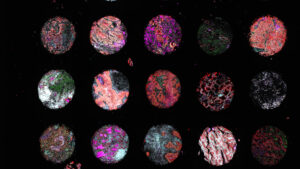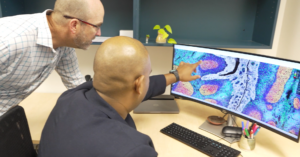
The annual American Association for Cancer Research meeting, fondly known as AACR, stands as a pinnacle gathering for cancer researchers and healthcare professionals alike. It’s truly a colossal event, with more than 23,000 registrants, hundreds of presentation on clinical trials, media from many high-profile news outlets, and attendees navigating through vast convention centers, inadvertently achieving their daily cardio goals amidst a whirlwind of sensations.
For everyone in cancer research, AACR holds a unique significance. Some might perceive it as an endurance test, grappling with sensory overload from ornate booth designs, concrete floors, crowds of people, and lots and lots of data. Others view it as a beacon of innovation, offering glimpses into the latest technological marvels and clinical trials arriving at their final stages of testing. And then there are those who cherish it as a time of reunion, an opportunity to reconnect with peers across diverse fields.
Yet, amidst this diversity of experiences, one unifying truth emerges: AACR is an indispensable cornerstone, a testament to the tireless efforts of countless individuals. Scientists, clinicians, cancer survivors, patients – all converge, united in their collective pursuit against cancer. It’s a critical juncture where we bear witness to the fruits of relentless dedication, a testament to our progress in this ongoing battle.
Throughout the course of the conference three key pillars of innovation were on display
- Spatial profiling
- Data analysis and artificial intelligence (AI)
- Vaccines for Cancer
Spatial Biology and Akoya’s Technology on the Path of Totality
At Akoya, we are thrilled to see the adoption of our technology by the cancer research community. With more than 70 posters featuring our technology and a Spotlight Theater presentation drawing standing-room-only crowds, it’s a true testament to the profound impact our customers are making in applying spatial biology to cancer medicine. This includes pushing our understanding of cancer and tissue dynamics to new limits by implementing novel assay and study designs across various application areas including spatio-temporal mapping the dynamics of cutaneous squamous cell carcinoma progression and immunotherapy response. Traditionally, studies with prospective elements and patient follow-ups posed significant hurdles. Side-by-side comparisons were arduous when restricted to one sample at a time. However, with multislide automation, this obstacle can be overcome. Moreover, scaling in plex presented its own set of challenges, yet with barcoding-based chemistry and rapid fluidics cycling, these limitations become far less inhibitive. The innovations throughout the PhenoCycler-Fusion 2.0 technology allows us to delve deeper into our research, facilitating studies with unprecedented depth and scope.
A bit earlier in the research continuum is the ability for PhenoCycler-Fusion 2.0 to rapidly develop high-plex neurobiology focused panels exploring the tumor immune landscape across different mouse modes of glioblastoma (GBM). GBM stands as a formidable adversary in the realm of cancer, presenting a complex challenge to clinicians and researchers alike. Despite strides in treatment, the prognosis remains bleak with a median survival time of 12-15 months and a five-year survival rate below 10. Preclinical animal models are important tools in unraveling the mysteries of GBM biology and assessing the efficacy of potential therapeutic interventions. Our research integrates the development of a customized 47-plex antibody panel designed for evaluating the tumor immune landscape in mouse models of GBM, spatial proteomic imaging, and an innovative bioinformatics analysis technique. Employing this comprehensive approach on the mouse GL261 GBM model enabled detailed examination of cell populations based on biomarker profiles and spatial distribution. This study offers a more profound understanding of the mouse GL261 model of GBM. We envision that further utilization of this panel will aid in identifying the most suitable model mirroring the intricate tumor microenvironment of human GBM, encompassing crucial features like invasive tumor margins, high vascularity, and the blood-brain barrier.
For a complete list of AACR posters showcasing Akoya technology pushing the boundaries of cancer research please visit our Literature page.
Data Analysis Solutions integrating AI
A plenary session at AACR delved into the expanding role of AI tools in oncology. Presenters emphasized the present and future impact of AI, envisioning its democratization in clinical research and trials. They discussed crucial considerations for AI implementation in medical imaging, stressing the importance of global health perspectives and equitable access to diverse data representation. Furthermore, scaling precision medicine through curated patient-level data and federated learning approaches was highlighted. What was also covered in detail was the need for rigorous validation in AI-driven biomarker discovery, exemplified by the development of a pan-tumor homologous recombination deficiency signature for guiding therapy.
Navigating the data from ultrahigh-plex spatial biology experiments is tough, but Akoya is tackling the challenge head-on. A recent two-part webinar series explores the allure of AI in this field.
Single-cell sequencing and spatial omics technologies now provide detailed molecular insights within cells while maintaining spatial context. However, integrating data across modalities remains tricky, especially when connections are weak.
In a recent webinar, Garry Nolan introduced MaxFuse, a method overcoming these challenges by consolidating proteomic, transcriptomic, and epigenomic information at single-cell resolution.
In part two, our partners, Enable Medicine discusses how advances in high-parameter spatial biology have flooded us with diverse biological data. They showcase how AI-powered algorithms within the Enable platform manage data storage, annotation, analysis, and search, enabling groundbreaking discoveries in life sciences.
Vaccines for Cancer: Are we there yet?
For years, researchers have pursued the dream of using vaccines to treat cancer, aiming to activate the body’s immune system against tumors. However, this pursuit has been fraught with challenges, from costly manufacturing to uncertainties about the most effective stimuli. But recent breakthroughs, partly inspired by the success of mRNA vaccines against COVID-19, are propelling this field forward.
AACR highlighted one area of focus; targeting shared neoantigens, which arise from common mutations across different tumor types. By developing vaccines that target these shared neoantigens, researchers aim to create off-the-shelf solutions that can be readily deployed to a wider range of patients.
As we look ahead to 2024, the landscape of cancer vaccines is evolving rapidly, driven by groundbreaking research and innovative collaborations, including a handful of studies that utilize the PhenoImager HT technology for this endeavor. With each new discovery, we move closer to realizing the full potential of immunotherapy in the fight against cancer.
The Spotlight Theater that Eclipsed Expectation
In a captivating session at the Spotlight Theater on April 8, attendees were treated to an exciting exploration of Spatial Biology 2.0, the ability to conduct studies at unprecedented scale and speed. Dr. Pascal Bamford unveiled Akoya’s revolutionary Spatial Biology 2.0 solutions, offering insights into cancer treatment response mechanisms and the potential for precision medicine. Joined by luminaries such as the 2023 Cure Cancer Researcher of the Year, Dr. Arutha Kulasinghe, and Dr. Suzanne Coberly from Bristol Myers Squibb, the event showcased Akoya’s transformative technologies, from PhenoCycler-Fusion 2.0 to PhenoImager HT 2.0 and PhenoCode Panels.
In his engaging presentation, Dr. Kulasinghe delved into a recent study centered on the 101-plex PhenoCycler-Fusion assay, built upon the hallmarks of cancer. This groundbreaking research not only unveiled intriguing biological insights but also underscored the imperative for scaling spatial proteomic assays.
Dr. Kulasinghe underscored the limitations of targeted applications with limited plex, emphasizing the transformative potential of technologies like molecular barcoding. These advancements will enable ultrahigh-plex spatial phenotyping studies, delving into the intricate mechanisms of cancer at the cellular level.To gain a deeper understanding of tissue dynamics, Dr. Kulasinghe emphasized the necessity of performing complementary assays, such as the ViewRNA assay and Akoya’s protein assay. Each assay plays a unique role in defining cell phenotypes and states within a tissue sample. By measuring both protein and RNA analytes, researchers can achieve a more comprehensive understanding of tumor progression, molecular interactions, and biological processes, ultimately facilitating the development of more precise biomarker signatures. He concluded with a thought-provoking scenario, envisioning a convergence of ultrahigh-plex discovery, metabolomics, transcriptomics, and high-throughput translational assays into a unified continuum, thus creating what he aptly termed “A systems biology view of cancer.”
Dr. Coberly highlighted her lab’s commitment to advancing targeted therapeutics and diagnostics, aimed at more precisely treating every patients individualized needs. Her lab continues to focus strongly on developing robust and user-friendly PhenoImager HT assays that can undergo clinical validation and seamlessly integrate into routine laboratory processes and continue demonstrating the practical utility of the HT platform, not only in research and clinical trials but also as a valuable tool in clinical settings, enabling precise patient targeting.
Every year, AACR stands out as a pivotal event where ideas flourish, old friendships rekindle, and significant business opportunities arise. Spatial biology may be complex and occasionally bewildering, but at Akoya, we’re fully committed to the journey. As we eagerly anticipate AACR 2025, we’re reminded of the profound significance of our scientific endeavors in striving to make a meaningful difference in the lives of patients. For now, we are excited to keep the conversations started at AACR going. Join us on May 22nd for a Fireside Chat as we discuss post-AACR spatial biology trends & decode cancer insights.





